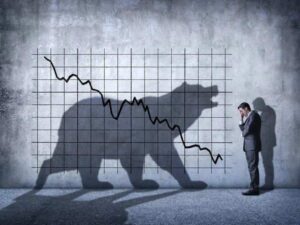In this blog post you are gonna know all about” What is a bull market in the stock market”.
Investing in stocks means continuously growing your money by taking advantage of market trends, protecting against losses and seizing opportunities during market ups and downs. Both bull and bear markets offer opportunities for growth, but they also come with risks. Making smart investment decisions requires discipline, consistency and focus. Investors with these qualities can thrive in bull markets.
A bull market occurs when stock prices rise consistently over an extended period of time, usually making investors optimistic. This trend often lasts for months or even years, with stocks performing better than other investments such as bonds. It is characterized by a significant increase in trading volume and purchases, usually at least 20% or more.
IMPORTANT HIGHLIGHTS
- Bull stock market indicate periods of optimism, investor confidence, and economic expansion in financial markets.
- Stock price increases during bull markets contribute to wealth creation, job growth and increased consumer confidence.
- While bull markets offer opportunities for investors, prudent risk management and long-term investment strategies are essential to effectively navigating market cycles.
Table of Contents
What Is A Bull Market In The Stock Market
A bull stock market is when prices in the market continue to rise or rise for an extended period of time, usually months or even years. It’s like when the economy is doing well, people are confident, and businesses are making good profits. This leads investors to feel positive about the stock market and invest more money in it. It is called a “bull” market because it attacks like a bull, driving prices up. So, simply put, it is a period when the value of stocks and other investments tends to rise for a period of time, which makes investors happy.

Understanding Bull Market
A bull stock market is a period in the stock market characterized by optimism, investor confidence, and expectations of sustained growth. They are challenging to predict because they rely on psychological factors and assumptions. Generally, a bull market is identified when a stock price rises at least 20% from a recent low, although there is no specific metric. Notable examples include the period 2003 to 2007, followed by the 2008 financial crisis.
Causes of Bull Markets:
Bull stock market usually coincide with a strong economy, characterized by strong GDP growth, low unemployment rates and rising corporate profits. Investor confidence is an important driver along with positive market sentiment and increased demand for stocks. While some factors such as corporate profits and the unemployment rate are measurable, others, such as market sentiment, are more challenging to measure.
Characteristics of a Bull Market:
During a bull stock market, trading volume typically increases as more investors buy and hold securities in anticipation of capital gains. Securities get higher valuations, and market liquidity improves with more demand and fewer sellers. Companies can reward shareholders with increased dividends and often raise initial public offerings (IPOs), which provide investors with an opportunity to participate in new ventures.
How to Invest in a Bull Market:
- Assess personal goals: Consider age and risk tolerance to make informed investment decisions.
- Take long positions: buy stocks at low prices and sell as prices rise.
- Invest in strong companies: Look for companies with a history of growth and strong fundamentals
- Consider Call Options: Use call options to profit from rising stock prices
- Buy Falling Stocks: Take advantage of opportunities during bear markets to buy stocks at low prices.
- Diversify the portfolio: Spread investments across stocks, bonds and other assets to manage risk.
- Include different stock classes and industries: Allocate investments to different sectors to capture growth opportunities and reduce sector-specific risks.
Recognizing a Bullish Market:
Identifying a bullish market involves observing several indicators:-
- Market Rally: Sustained upward movement in stock prices.
- Rising Volatility Indicator: Price volatility increases during bullish trends.
- Lower bond yields: Lower interest rates encourage equity investment.
- Strong economic fundamentals: including GDP growth and low unemployment rates.
Here’s The Best Online Brokers for your investment journey:-
[ Do not influence by our recommendation. It’s entirely your responsibility to find the best broker ]
Impact of Bull Markets on Countries:
Bull stock market contribute to economic growth by increasing incomes, consumer spending and business investment. They lead to higher GDP, lower unemployment and better standard of living. Strong economic policy, performance of large-cap companies, and business cycle fluctuations affect the prevalence of bull markets.
Economic growth:
Bull stock market are often associated with periods of strong economic expansion. Rising stock prices increase consumer confidence and wealth, which in turn increases spending and investment. This, in turn, stimulates economic activity, drives corporate profits and contributes to overall GDP growth.
Wealth Creation:
Bull markets create significant opportunities for investors to accumulate wealth, especially those investing in stocks and equities. As stock prices rise, investors see gains in their investment portfolios, thereby increasing wealth and financial security.
Job creation:
Strong stock market performance is often correlated with a healthy economy and low unemployment rates. During bull markets, businesses are more confident about future prospects and may increase hiring to meet growing demand, thereby creating jobs and reducing unemployment.
Consumer Confidence:
Rising stock prices and economic prosperity during bull markets lead to positive consumer sentiment. Increased confidence among consumers encourages spending on goods and services, further accelerating economic growth and prosperity.
Investor Behavior:
Bull markets can influence investor behavior, thereby increasing risk-taking and speculative activity in financial markets. While this can contribute to market volatility and asset bubbles, it also provides opportunities for investors to capitalize on rising asset prices and profit.
[Overall, bull markets play an important role in driving economic growth, creating wealth, and shaping investor attitudes and behavior. However, it is essential to recognize that bull markets are cyclical and eventually give way to market downturns, highlighting the importance of prudent risk management and long-term investment strategies.]
Bull Market History:
Bull markets have been observed throughout history, often coinciding with periods of economic expansion and investor optimism. These periods are characterized by sustained increases in stock prices and overall market confidence. Notable examples include:
The Roaring Twenties:
After World War I, the United States experienced a period of rapid economic growth and industrial expansion. This era, known as the Roaring Twenties, saw a remarkable bull market characterized by soaring stock prices, particularly in industries such as automobiles, consumer goods, and technology.
The dot-com bubble:
The dot-com bubble: In the late 1990s, the rise of the Internet and technological advances led to a speculative frenzy in the stock market, particularly in Internet-based companies. The period known as the dot-com bubble saw astronomical valuations of tech stocks and massive investor euphoria. However, the bubble finally burst in the early 2000s, causing a severe downturn in the market.
The Great Bull Market of the 1980s and 1990s:
The 1980s and 1990s witnessed the longest and most significant bull market in history. Factors such as deregulation, globalization and technological innovation have accelerated economic growth and driven stock prices to new heights. This long period of prosperity saw the rise of iconic bull market figures like Warren Buffett and the rapid rise of companies like Microsoft, Apple and Walmart.
Conclusion
In conclusion, bull markets represent periods of optimism, investor confidence and economic expansion in financial markets. These periods are characterized by sustained increases in stock prices, driven by factors such as strong economic fundamentals, corporate profits and positive investor sentiment. Bull markets play an important role in driving economic growth, creating wealth, and encouraging innovation and entrepreneurship. However, it is important for investors to exercise caution and prudence, as bull markets are inevitably followed by market corrections or downturns.
By maintaining a diversified investment portfolio, staying aware of market trends and adhering to a long-term investment strategy, investors can effectively navigate bull markets and capitalize on the opportunities that present themselves while minimizing potential risks. Ultimately, bull markets are an integral part of the market cycle, representing periods of prosperity and growth that contribute to the overall resilience and dynamism of the global economy.









1 thought on “What Is A Bull Market In The Stock Market- For Beginners 2024”